How the little green man took over the world – while his designer went forgotten
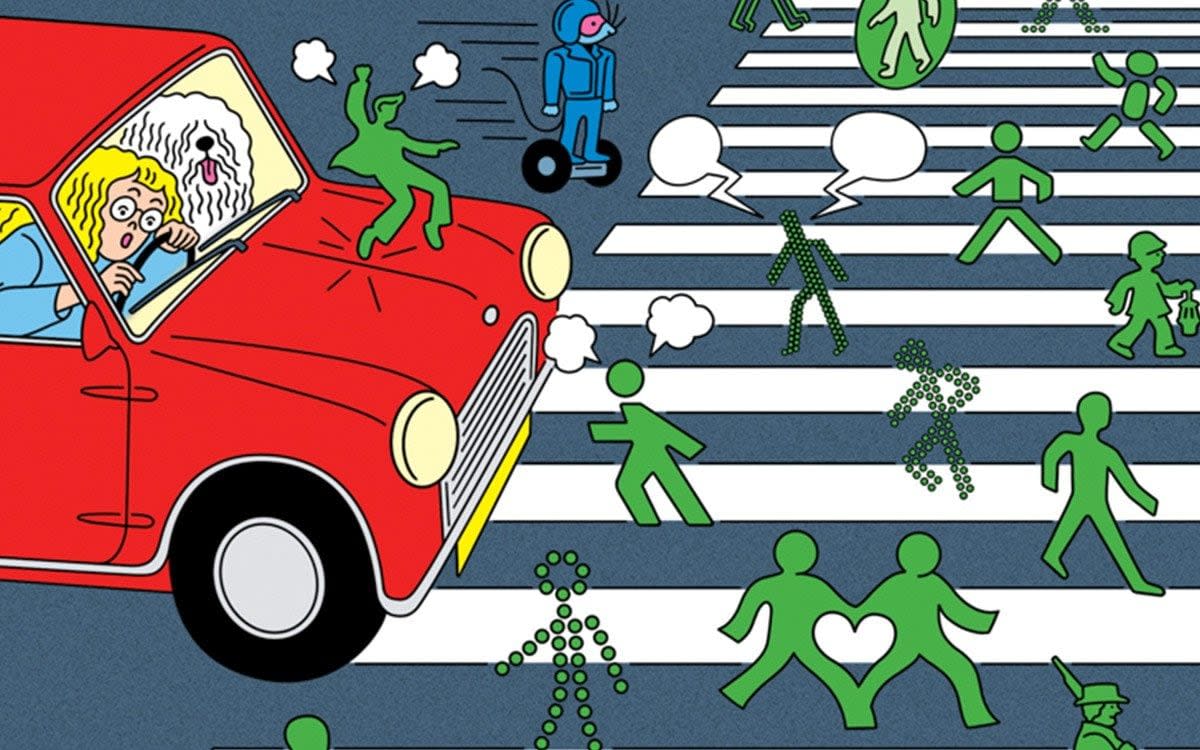
- Oops!Something went wrong.Please try again later.
Whenever I go to a different country, I do the same five things. Firstly – as soon after passport control as is physically possible – I go to the supermarket. Endless joy can be found in the subtle ways their cereals differ from ours and the unusual seasonings they put on their crisps. In a similar vein, I marvel at the menu in McDonald’s. Lest you think I’m uncultured, I also go to a central place of worship. Then I look in charity shops to see what people wore here in days gone by. Finally, often incidentally: I check out the green man.
Wherever you go, he goes – indeed, he leads the way. All over the globe, an illuminated walking figure tells us when it’s safe to cross the road. I have come to believe – completely baselessly – that differences in our national temperaments are reflected in subtle variations between green men. In France he is so tall and slender – surely a result of all those cigarettes? In Denmark, his chest is strong – something to do with his Viking roots? In Japan he wears a little hat and his hems are crisp – a suitable figure for such a stylish land.

My travelling companions rarely share my fascination. It would be unfair to say that no one looks at the green man twice – we do, we look at him multiple times a day. Perhaps it’s better to say that no one really sees him; he blends into the landscape like a twig, a leaf, or an unremarkable cloud. We all know where he’s going: he is forever confidently striding ahead. But no one – not even the experts you’d expect to care about this kind of thing – really knows where he came from.
How did the green man take over the globe? The designers behind his many variations are largely lost to history. Margaret Calvert, the graphic designer responsible for Britain’s road signs, has an OBE, while the American inventor of the traffic light, Garrett Morgan, has schools named after him, but neither are credited with the green man’s creation. The people behind the world’s green men don’t seem to be remembered for their pervasive designs. It’s a shame – because if we look a little closer, we might find that these figures symbolise far more than the word ‘walk’.
‘“Saints” will tell when to cross road’ ran a headline in the Paddington Mercury on Friday 13 September 1963. That autumn, a regulation known as the ‘Controlled Areas (Pedestrians) Experimental Order’ was enacted in three London boroughs – it made it an offence to cross the road anywhere but at newly installed pedestrian crossings between 7am and 7pm. The Paddington Mercury nicknamed the illuminated men on the crossings ‘saints’ after the stick figures on author Leslie Charteris’s book covers for his long-running series The Saint. The design was limited because the men were made out of tubing – they looked like a child’s drawing, a big circle on single line limbs.
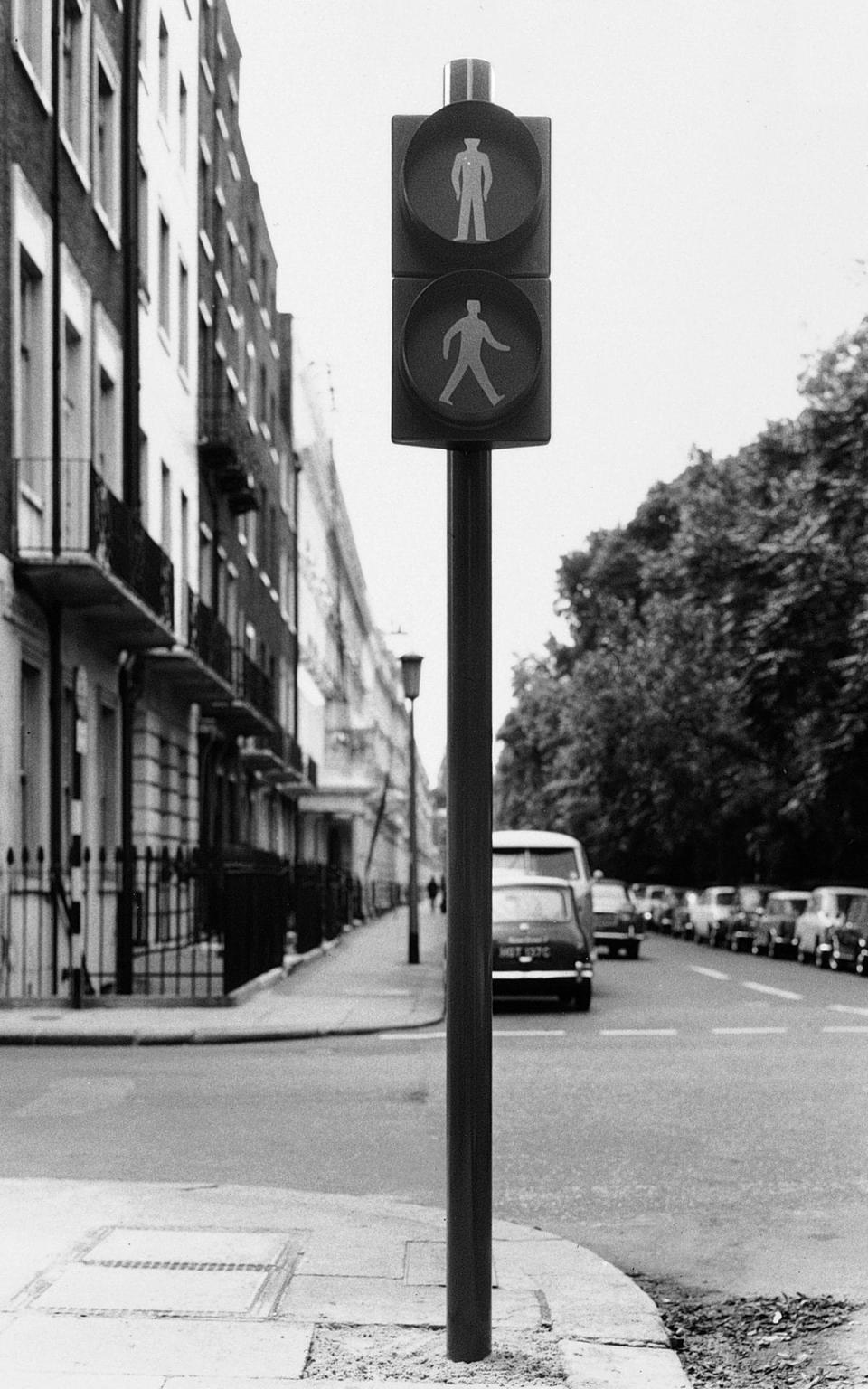
Nowadays, around 19,000 pedestrians are killed or injured by cars in Great Britain each year – in 1961, that figure was over 72,000, of whom 30,000 were children. No wonder, then, that the so-called ‘matchstick man’ experiment was a hit – Design Council chairman Sir Walter Worboys mandated the use of red and green figures in his revolutionary Traffic Sign Regulations and General Directions 1964. Illuminated pedestrian crossings were not new – from the 1930s, crossings in Britain experimented with the words ‘CROSS NOW’ and ‘DON’T CROSS’ – but Worboys was inspired by the use of symbols on the Continent.
Where on the Continent? Who designed the first green man? The Worboys Committee paperwork is vague. In 1949, the Geneva Convention on Road Traffic produced a protocol on road signs – a hatted man in a triangle indicated when a pedestrian crossing was coming up, but the crossings themselves were left up to individual authorities.
Surely, though, we must know who designed our green man in the 1960s, his arms tapering into sleek points, his legs wide? Although there are boxes upon boxes of letters and plans in Britain’s National Archives, the green man’s parentage cannot be confirmed. The design is similar to the pedestrian figure drawn by Margaret Calvert for her triangular warning signs, but hers had hands, bent knees and no sharp chin – she says she didn’t work on the green man. A spokesperson from the Department for Transport says he was drawn by famous cutlery designer David Mellor, who was commissioned to redesign Britain’s traffic lights in 1965 and died in 2009.
‘The ministry of transport obviously think my father did it, so I’m sure he did,’ says David’s son, Corin – but actually, he can’t be sure. When he was a child, everyone in the family car would joke when they stopped at a traffic light, admiring his dad’s work – but no one really made similar comments at pedestrian crossings.’
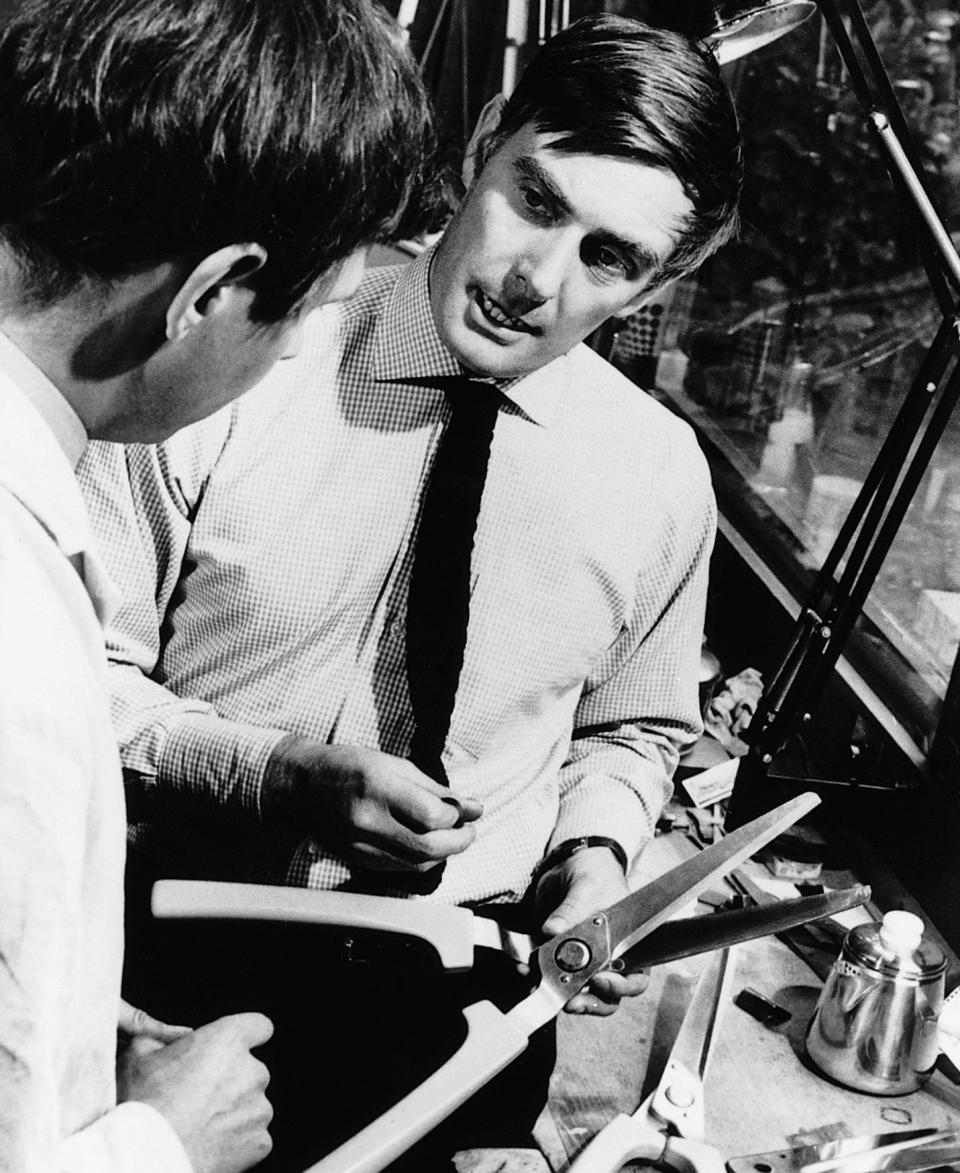
‘We haven’t got any drawings of the green man in our archive,’ says 57-year-old, Derbyshire-based Corin, also a designer. Mellor’s archived drawings focus on the structure of traffic lights – the posts, brackets and push-button boxes. Corin speculates that an illustrator Mellor worked with, David Higham, could have drawn the green man.
Or it may have been someone at one of the two manufacturers bringing Mellor’s designs to life, GEC Road Signals and Plessey Co. In one 1968 letter to the Ministry of Transport, Mellor asked for ‘two more copies of the pedestrian key label showing the red and green men’. If it was the manufacturer, then Penny While, spokesperson at UK transport research centre TRL, notes that, ‘In this period, individuals were rarely credited with inventions, everything was seen as a team effort. So you are unlikely to be able to say the green man was invented by a specific person.’
Regardless of whether Mellor designed the figure, it’s clear no one cared enough to remember. Corin says people take the green man for granted because he’s ‘just there, so no one has ever tried to dig him up. Good design is like that – good design sits there quietly and it does its job.’
The same is true of green men globally. In 1968, the Vienna Convention on Road Signs and Signals was ratified – signatories agreed that pedestrian lights, ‘shall be arranged vertically, with the red light always at the top and the green light always at the bottom. The red light shall preferably be in the form of a standing pedestrian… and the green light in the form of a walking pedestrian.’
When I contact other transport authorities, they too express uncertainty about the origins of their men. Kristofer from Sweden knows he was introduced in 1966, but can’t find the designer. Michel in France says the signal is called ‘R12’ and was launched in 1974, but he also can’t locate the official design. Jaap from The Netherlands initially can’t help, but then he speaks to a colleague who claims a woman named Lianda van der Zwaag designed the nation’s man in 1969. He can’t verify this, however, and ‘the colleague who knew this information knew it through a pub quiz’.
Even relatively recent designs, such as the ‘green women’ implemented in Melbourne in 2017, have obscure origins. Matt Gaffney of Committee for Melbourne says the design came from ‘an anonymous person online’ who responded to a prompt on an outsourcing platform like Airtasker.
Perhaps local authorities prefer it this way – after all, if someone staked a claim as the creator of a green man, the royalty fees could be enormous. In Taiwan, an animated man known as Xiaolüren debuted in 1999 – he was allegedly designed by multiple agencies, including the Taipei City Government, but one 2006 article (on a now dead link) claims that the true ‘father of the little green men’ wanted to file an infringement complaint. (Officials at the Taipei City Traffic Engineering Office did not respond to repeat emails.)
Corin says that if his father did design the green man, it fits: ‘It’s anti-fashion, my father never followed fashion, and he was very keen on things being subtle.’ In cases where we can track down designers, we can see just how much this little figure can symbolise.
‘Sophie was born on a warm sunny day in July,’ says Marij Nielen, a 68-year-old artist from The Netherlands. The council of Amersfoort approached Nielen in 1999 because they wanted to play a practical joke for the new millennium by transforming some of the traffic lights in the town. Nielen says she was employed as the designer because the council wanted ‘somebody who was not that keen on having the rights. They wanted someone with not such a big ego because they wanted to keep it secret so they could change the lights overnight.’
Nielen created an image she could ‘relate’ to – it was only ‘natural’, she says, for her to draw a woman. She was paid €1,000 for her design, and one day in the year 2000, the townspeople of Amersfoort awoke to find that ‘Sophie’ had replaced the green man. Sophie walks with a confident sashay, her arms and ponytail swinging. Her calves are muscled and strong; she wears high heels on her feet.
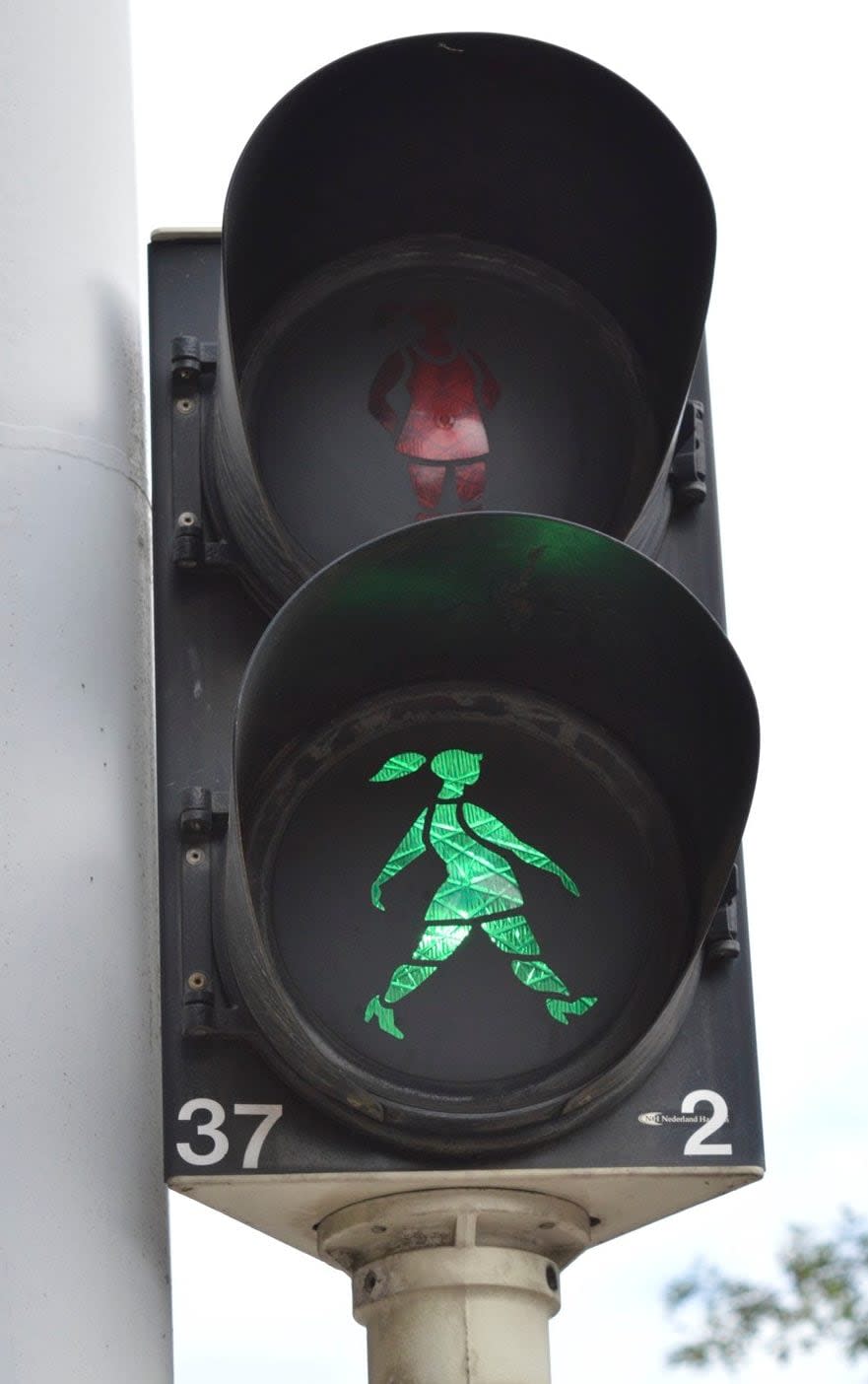
To Nielen, Sophie has a personality. ‘She is inclined to seize new opportunities and is a bit cheeky in doing so’ – she’s a dreamer with a vivid imagination, she likes to stay active, and she is a trendsetter, not a follower. ‘She has been in love a few times, but that didn’t last long.’
There were a few technical limitations to Sophie’s design – she has gaps between her limbs because it would have been hard for the manufacturer to make her in one piece, and her legs had to be spread so she was recognisably walking. Everything else was Nielen’s choice. ‘I wanted her to have a real body which you can touch, which you can love, she mustn’t be dead skinny.’ Nielen stresses that she drew a woman, not a child; the red version of Sophie has breasts which Nielen says some cities remove when they copy her design. ‘They want to make it a girl,’ she says, ‘so they can dominate it again.’
Initially, no one in Amersfoort knew that Nielen had designed Sophie – she thought it was better this way, because then everyone on the street could see themselves in Sophie, rather than thinking about her creator. After a few years, Nielen decided to reveal her identity as the designer on Wikipedia. One of the only other artists credited with a green man design on Wikipedia is Swedish illustrator Kåge Gustafson, who created a figure colloquially known as Herr Gårman, a pun that sounds like ‘you walk here’ in Swedish. (Herr Gårman is mostly used on road signs, but can be found on some lights.) Nielen’s Sophie has since travelled the globe, appearing as far afield as Winnipeg and New York, but her permanent residence remains Amersfoort.
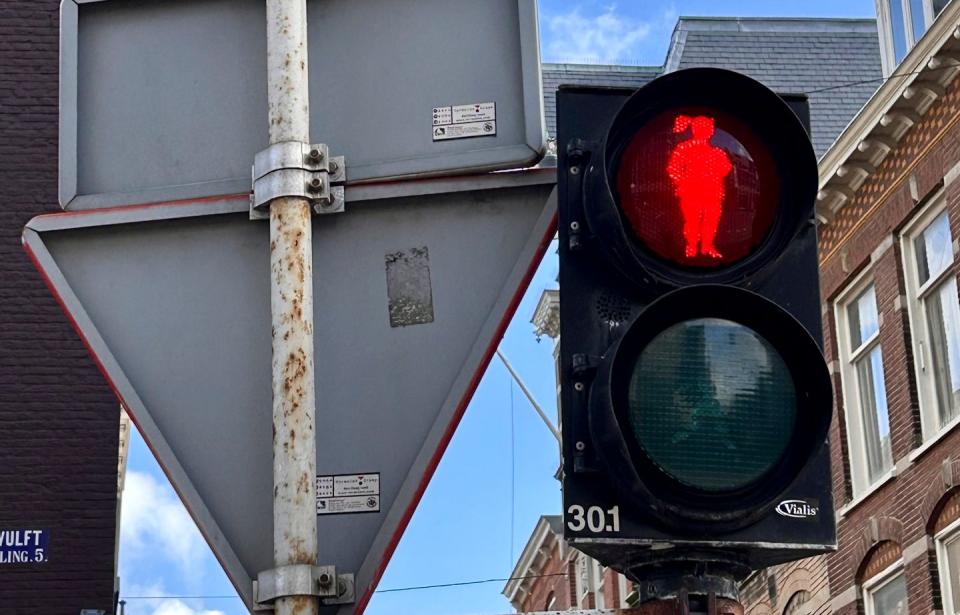
Magnus Holm’s friends don’t believe him when he says he fathered the lights in Fredericia, Denmark. When he was nine, he went on holiday to Odense and admired the lights shaped like author Hans Christian Andersen – he thought his hometown should have personalised green men, too. A memorial to unknown soldiers, the ‘Landsoldatpladsen’, has become a symbol of Fredericia since it was erected in 1858 – Holm emailed the mayor and asked if it could be put on the lights.
In the late 2000s, Holm’s idea came to life; soldier-shaped lights were installed. ‘I was proud because I had contributed to something in the town where everybody sees it every day,’ says the 27-year-old, now a doctor living in Funen. A proud Fredericianer, Holm feels it’s important we keep hold of local symbols in an increasingly globalised world. ‘I think it’s important to remember where you come from.’
Michael Sax is a global product manager at Yunex Traffic, a German company which provides pedestrian signal heads for 600 cities across the globe. Sax says that in the last decade, more and more localities have sought to personalise their lights like this. He scrolls through a spreadsheet of green men symbols, revealing a bushy-tailed fox walking on its hindlegs, Karl and Jenny Marx, a bishop, and even an angel. Yunex does not create these designs – which are sent to them by local authorities – but manufactures and tests them, ensuring they emit enough light.
‘I would say in percentages, it’s only 10 per cent of cities who ask for these special things and the rest just take the country’s standard, they don’t care,’ Sax says. Yet when they do care, Sax notes that green men can transmit powerful messages. Last year, Yunex created wheelchair user traffic signals for TfL, which Olympian Pete Reed said represented ‘progress, positivity and possibility’.
In New Zealand, green men dancing the Haka have been installed for Māori festivals, plus symbols shaped like suffragette Kate Sheppard and trans activist Carmen Rupe. Sax recalls helping Munich install same-sex couple lights to celebrate the LGBT+ community in 2015. ‘They just wanted to give a sign: you are all welcome.’
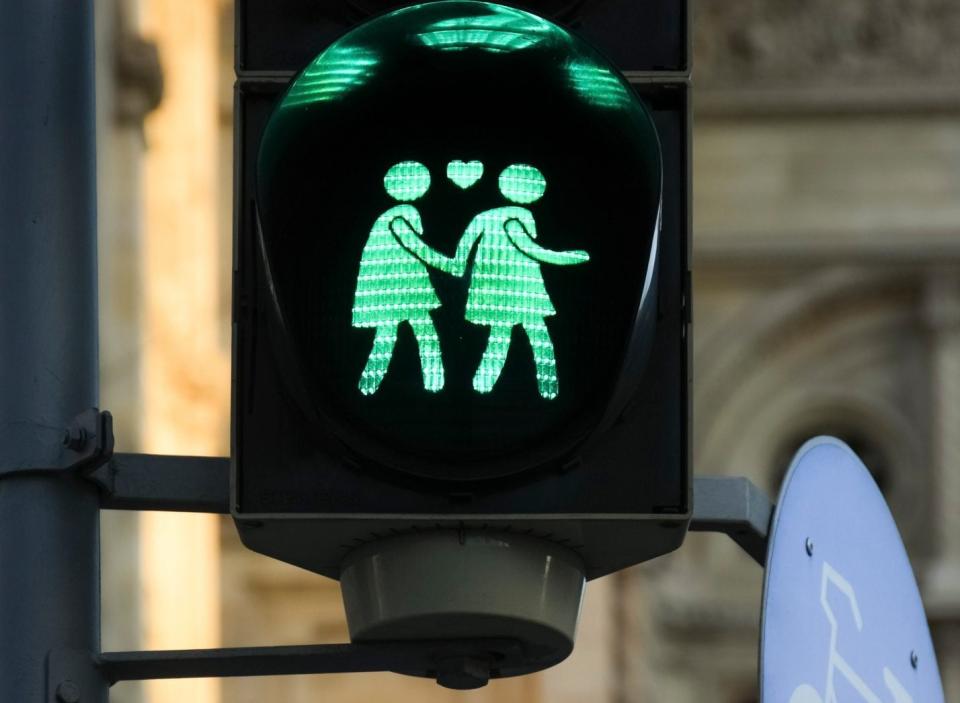
Of course, most green men are agnostic, they only tell us when it’s safe to cross the road. Even so, their little differences are fascinating. Poland’s man is stiff, made up of disjointed angular lines. Andorra’s is fabulous, its circular head atop wave-shaped arms and big curved legs. In some parts of Mongolia, the green man is riding a galloping horse. There’s a light shaped like the cartoon bunny Miffy in Utrecht and some shaped like Mexican Lele dolls in Querétaro. But for all the endlessly enjoyable variations, there is a king among green men: the East German ‘Ampelmännchen’.
It almost looks like he’s carrying a pizza box. The rim of his hat is distinct – his shoes are sharp too, and his stride is effortlessly powerful. He’s thicker and squatter than other green men, which ultimately means that he looks very cute. He was created by traffic psychologist Karl Peglau and his secretary Anneliese Wegner in 1961 and installed across East Berlin.
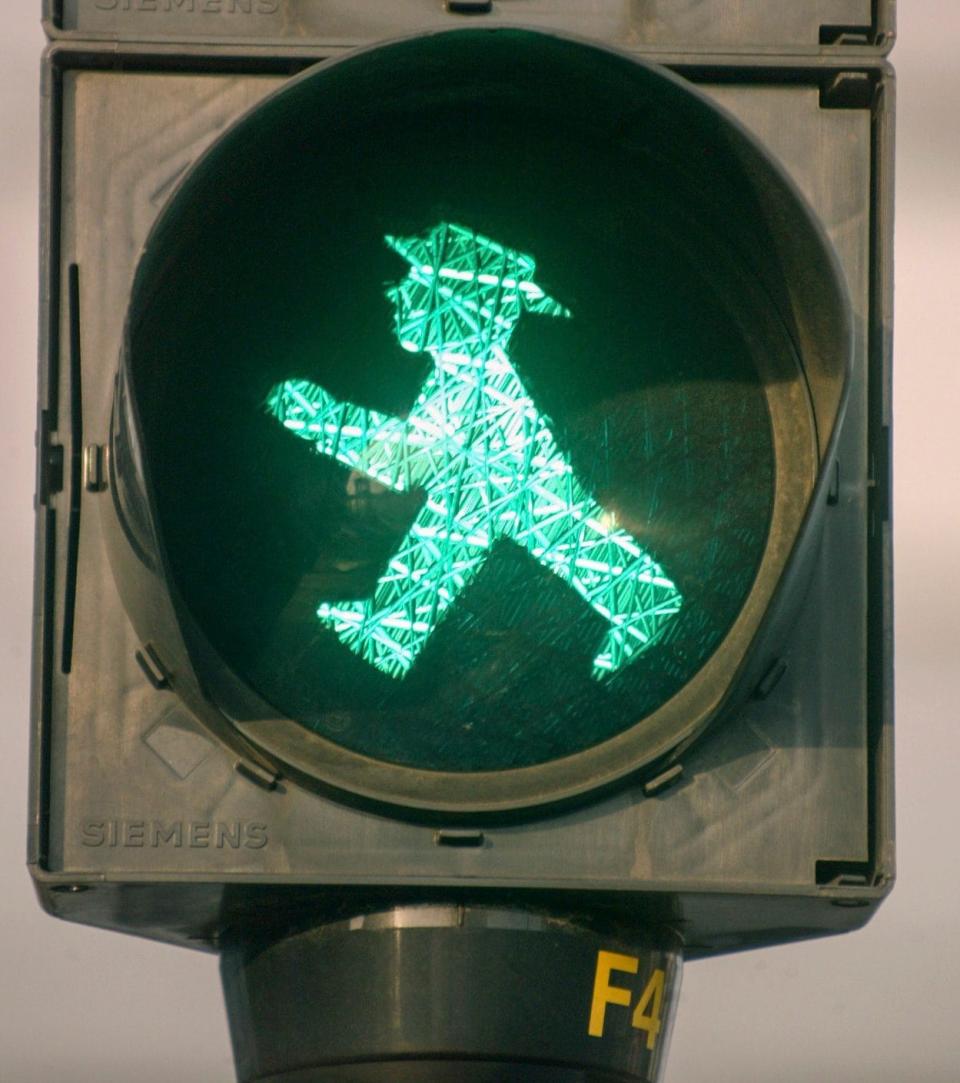
‘He’s so charming because he’s so small, a little bit like a child,’ says 63-year-old Markus Heckhausen, who became enamoured with the Ampelmännchen after the Berlin Wall fell. Heckhausen was distressed to see that the man was slowly being replaced with the West German version and asked a construction worker if he could take a discarded traffic light, which he intended to make into a lamp. From there he built Ampelmann, a brand with five shops across Berlin.
Although Heckhausen finds the Ampelmännchen cute, he notes he is ‘also so serious’: ‘He is this man who is working for us 24 hours.’ In 1996, Heckhausen met Peglau and wrote a book about the green man – the press generated meant that authorities saved the remaining Ampelmännchen, which are still in place today. ‘I think it’s the only traffic light man that has such a big concept behind it,’ Heckhausen says, explaining it was designed to appeal to children, with a big head to emit the maximum amount of light. Its shoes point forward like arrows. Whenever he travels, Heckhausen takes photos of other green men.
While many of these symbols have forgotten origins, Heckhausen and I are not the only people who care. Dennis is a self-described ‘influencer for traffic lights since 2009’. The 39-year-old from Germany runs a website and YouTube channel, Ampelfreund, in which he documents his collection of 24 traffic lights. His family ‘tolerate but hate’ his hobby, yet it brings him great joy. ‘Everything is art for me,’ he says.
Then there’s artist Maya Barkai, who launched the ‘Walking Men Worldwide’ project in 2010. She asked photographers around the globe to submit images of their local green men and the resulting collage has been exhibited in many parts of the world. Her website describes the green man as ‘an international celebrity, a graphic sign that transcends all languages and places’.
Barkai, now 43 and living in New York, agrees that we can read into the ‘body language’ of green men and, like me, feels their design is an under-appreciated art. Mostly, she’s happy that her project allowed her to connect with others around the world. ‘People can come from different places and there’s so much that they bring along culturally and politically, but when you ask them to look at the traffic light, it’s like a point of connection.’
My journey into the world of green men did not go as I expected – instead of striding confidently forwards, I was met with many road blocks. It’s disappointing to not get a simple answer from, say, a designer in France: ‘Yes, I drew the green man that way so that he would be très chic.’ The tiny variations between these symbols will continue to keep my brain whirring – why is he swaggering in Rome but sneaking around in Moscow? Is he wearing flares in Valdivia? It’s a shame that the people who created these symbols are mostly forgotten – but at least the green man himself walks on.

